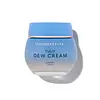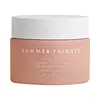What's inside
What's inside
 Key Ingredients
Key Ingredients

 Benefits
Benefits

 Concerns
Concerns

No concerns
 Ingredients Side-by-side
Ingredients Side-by-side

Water
Skin ConditioningCoco-Caprylate/Caprate
EmollientSqualane
EmollientHelianthus Annuus Seed Oil
EmollientNiacinamide
SmoothingPropanediol
SolventGlyceryl Stearate
EmollientSodium Starch Octenylsuccinate
AbsorbentSclerotium Gum
Emulsion StabilisingTocopheryl Acetate
AntioxidantTulipa Hybrid Flower Extract
Skin ConditioningHydrolyzed Sodium Hyaluronate
Skin ConditioningSodium Hyaluronate
HumectantGlycerin
HumectantPanthenol
Skin ConditioningGluconolactone
Skin Conditioning3-O-Ethyl Ascorbic Acid
Skin ConditioningSimmondsia Chinensis Seed Oil
EmollientArginine
MaskingVitis Vinifera Seed Oil
EmollientDaucus Carota Sativa Seed Oil
EmollientAscorbyl Palmitate
AntioxidantCucurbita Pepo Seed Extract
Skin ConditioningPyrus Malus Fruit Extract
Skin ConditioningDaucus Carota Sativa Root Extract
Skin ConditioningCalcium Gluconate
HumectantHydroxypropyl Starch Phosphate
Caprylyl Glycol
EmollientSodium Gluconate
Skin ConditioningSodium Lactate
BufferingSodium Benzoate
MaskingCitric Acid
BufferingPotassium Sorbate
PreservativePhenethyl Alcohol
MaskingWater, Coco-Caprylate/Caprate, Squalane, Helianthus Annuus Seed Oil, Niacinamide, Propanediol, Glyceryl Stearate, Sodium Starch Octenylsuccinate, Sclerotium Gum, Tocopheryl Acetate, Tulipa Hybrid Flower Extract, Hydrolyzed Sodium Hyaluronate, Sodium Hyaluronate, Glycerin, Panthenol, Gluconolactone, 3-O-Ethyl Ascorbic Acid, Simmondsia Chinensis Seed Oil, Arginine, Vitis Vinifera Seed Oil, Daucus Carota Sativa Seed Oil, Ascorbyl Palmitate, Cucurbita Pepo Seed Extract, Pyrus Malus Fruit Extract, Daucus Carota Sativa Root Extract, Calcium Gluconate, Hydroxypropyl Starch Phosphate, Caprylyl Glycol, Sodium Gluconate, Sodium Lactate, Sodium Benzoate, Citric Acid, Potassium Sorbate, Phenethyl Alcohol
Water
Skin ConditioningPropanediol
SolventDicaprylyl Carbonate
EmollientGlycerin
HumectantPentylene Glycol
Skin ConditioningSodium Hyaluronate
HumectantHydrolyzed Sodium Hyaluronate
Skin ConditioningGlycine
BufferingSerine
MaskingGlutamic Acid
HumectantAspartic Acid
MaskingLeucine
Skin ConditioningAlanine
MaskingLysine
Skin ConditioningArginine
MaskingTyrosine
MaskingPhenylalanine
MaskingProline
Skin ConditioningThreonine
Valine
MaskingIsoleucine
Skin ConditioningHistidine
HumectantAscorbic Acid
AntioxidantSaccharide Isomerate
HumectantHaematococcus Pluvialis Extract
AntioxidantCeramide NP
Skin ConditioningTocopheryl Acetate
AntioxidantTocopherol
AntioxidantHexapeptide-11
Skin ConditioningPalmitoyl Tripeptide-1
Skin ConditioningAnanas Sativus Fruit Extract
Skin ConditioningSaccharomyces/Magnesium Ferment
Saccharomyces/Copper Ferment
Skin ConditioningSaccharomyces/Silicon Ferment
Skin ConditioningButylene Glycol
HumectantGlyceryl Acrylate/Acrylic Acid Copolymer
HumectantGlyceryl Caprylate
EmollientSucrose Stearate
EmollientLecithin
EmollientPolyglyceryl-10 Laurate
Skin ConditioningXanthan Gum
EmulsifyingCetearyl Olivate
Sorbitan Olivate
EmulsifyingSodium Citrate
BufferingCarbomer
Emulsion StabilisingCitric Acid
BufferingCetearyl Alcohol
EmollientSodium Hydroxide
BufferingLactobacillus Ferment
Skin ConditioningLeuconostoc/Radish Root Ferment Filtrate
AntimicrobialHydroxyacetophenone
AntioxidantCI 77491
Cosmetic ColorantWater, Propanediol, Dicaprylyl Carbonate, Glycerin, Pentylene Glycol, Sodium Hyaluronate, Hydrolyzed Sodium Hyaluronate, Glycine, Serine, Glutamic Acid, Aspartic Acid, Leucine, Alanine, Lysine, Arginine, Tyrosine, Phenylalanine, Proline, Threonine, Valine, Isoleucine, Histidine, Ascorbic Acid, Saccharide Isomerate, Haematococcus Pluvialis Extract, Ceramide NP, Tocopheryl Acetate, Tocopherol, Hexapeptide-11, Palmitoyl Tripeptide-1, Ananas Sativus Fruit Extract, Saccharomyces/Magnesium Ferment, Saccharomyces/Copper Ferment, Saccharomyces/Silicon Ferment, Butylene Glycol, Glyceryl Acrylate/Acrylic Acid Copolymer, Glyceryl Caprylate, Sucrose Stearate, Lecithin, Polyglyceryl-10 Laurate, Xanthan Gum, Cetearyl Olivate, Sorbitan Olivate, Sodium Citrate, Carbomer, Citric Acid, Cetearyl Alcohol, Sodium Hydroxide, Lactobacillus Ferment, Leuconostoc/Radish Root Ferment Filtrate, Hydroxyacetophenone, CI 77491
 Reviews
Reviews

Ingredients Explained
These ingredients are found in both products.
Ingredients higher up in an ingredient list are typically present in a larger amount.
Arginine is an amino acid that is important for human development. Your body uses is it to produce hair keratin and skin collagen.
As a cosmetic ingredient, Arginine has antioxidant properties and can also help repair damaged skin. This ingredient is derived either synthetically or from animals.
Arginine isn't fungal acne safe when used in the presence of other lipids (fats, fatty acids, oils, esters, etc). Oils and fats occur naturally within the skin, so take caution when using Arginine if you're prone to fungal acne.
Learn more about ArginineCitric Acid is an alpha hydroxy acid (AHA) naturally found in citrus fruits like oranges, lemons, and limes.
Like other AHAs, citric acid can exfoliate skin by breaking down the bonds that hold dead skin cells together. This helps reveal smoother and brighter skin underneath.
However, this exfoliating effect only happens at high concentrations (20%) which can be hard to find in cosmetic products.
Due to this, citric acid is usually included in small amounts as a pH adjuster. This helps keep products slightly more acidic and compatible with skin's natural pH.
In skincare formulas, citric acid can:
While it can provide some skin benefits, research shows lactic acid and glycolic acid are generally more effective and less irritating exfoliants.
Most citric acid used in skincare today is made by fermenting sugars (usually from molasses). This synthetic version is identical to the natural citrus form but easier to stabilize and use in formulations.
Read more about some other popular AHA's here:
Learn more about Citric AcidGlycerin is already naturally found in your skin. It helps moisturize and protect your skin.
A study from 2016 found glycerin to be more effective as a humectant than AHAs and hyaluronic acid.
As a humectant, it helps the skin stay hydrated by pulling moisture to your skin. The low molecular weight of glycerin allows it to pull moisture into the deeper layers of your skin.
Hydrated skin improves your skin barrier; Your skin barrier helps protect against irritants and bacteria.
Glycerin has also been found to have antimicrobial and antiviral properties. Due to these properties, glycerin is often used in wound and burn treatments.
In cosmetics, glycerin is usually derived from plants such as soybean or palm. However, it can also be sourced from animals, such as tallow or animal fat.
This ingredient is organic, colorless, odorless, and non-toxic.
Glycerin is the name for this ingredient in American English. British English uses Glycerol/Glycerine.
Learn more about GlycerinThis ingredient is created by putting sodium hyaluronate through hydrolysis.
You might know this as 'mini' or 'ultra low-molecular weight' hyaluronic acid. The small molecule size means it is able to travel deeper in the skin.
According to studies, low molecular-weight hyaluronic acid can:
One study from 2011 found ultra-low weight HA to show pro-inflammatory properties. Another study from 2022 found it to downregulate UV-B induced inflammation.
Hydrolysis is a process of changing a molecule using water or enzymes.
This ingredient is water-soluble.
Learn more about Hydrolyzed Sodium HyaluronatePropanediol is an all-star ingredient. It softens, hydrates, and smooths the skin.
It’s often used to:
Propanediol is not likely to cause sensitivity and considered safe to use. It is derived from corn or petroleum with a clear color and no scent.
Learn more about PropanediolSodium Hyaluronate is hyaluronic acid's salt form. It is commonly derived from the sodium salt of hyaluronic acid.
Like hyaluronic acid, it is great at holding water and acts as a humectant. This makes it a great skin hydrating ingredient.
Sodium Hyaluronate is naturally occurring in our bodies and is mostly found in eye fluid and joints.
These are some other common types of Hyaluronic Acid:
Learn more about Sodium HyaluronateTocopheryl Acetate is AKA Vitamin E. It is an antioxidant and protects your skin from free radicals. Free radicals damage the skin by breaking down collagen.
One study found using Tocopheryl Acetate with Vitamin C decreased the number of sunburned cells.
Tocopheryl Acetate is commonly found in both skincare and dietary supplements.
Learn more about Tocopheryl AcetateWater. It's the most common cosmetic ingredient of all. You'll usually see it at the top of ingredient lists, meaning that it makes up the largest part of the product.
So why is it so popular? Water most often acts as a solvent - this means that it helps dissolve other ingredients into the formulation.
You'll also recognize water as that liquid we all need to stay alive. If you see this, drink a glass of water. Stay hydrated!
Learn more about Water